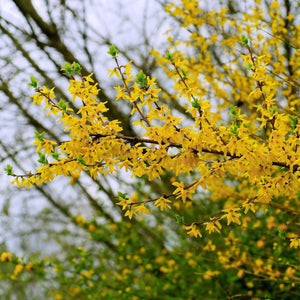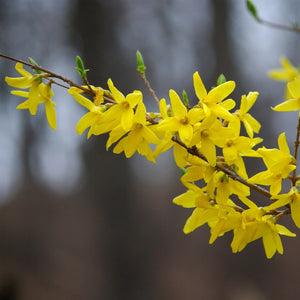The Forsythia Guide
As a landscape emerges from winter's grasp, forsythias emerge as nature's brilliant maestros, their arching branches adorned in a cascade of golden blooms. Serving as a vibrant overture to the warmer seasons, these deciduous shrubs not only announce the end of winter but embody the essence of renewal. Forsythias, with their adaptable nature, add a touch of exuberance to any landscape, flourishing in diverse conditions and gracing gardens with their radiant hues. From creating lively borders to dazzling hedges or standalone features, forsythias invite both seasoned gardeners and beginners to partake in the joyous crescendo of spring, turning outdoor spaces into vibrant havens buzzing with life.
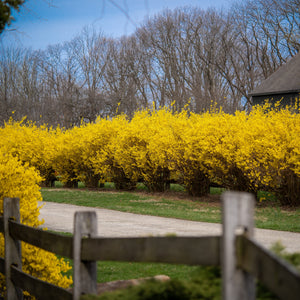
About
Forsythia, a harbinger of spring's vibrant arrival, graces gardens with its spectacular display of golden blooms. As a deciduous shrub, forsythia belongs to the Oleaceae family and stands out for its arching branches adorned with clusters of bright yellow flowers. Celebrated for its captivating presence and ecological significance, forsythia has become a symbol of the changing seasons and a floral spectacle that welcomes the warmer months.
The hallmark feature of forsythia lies in its profusion of blooms that emerge before the foliage, transforming the shrub into a cascade of radiant yellow hues. This early burst of color creates a visual symphony, marking the end of winter dormancy and the beginning of spring's lively awakening. The vibrant flowers add a touch of warmth to landscapes and serve as a beacon for pollinators, including bees and butterflies.
Forsythia's deciduous nature contributes to the dynamic tapestry of gardens, showcasing a progression of life from bare winter branches to a lush green backdrop in the summer. Its adaptability allows it to thrive in various soil types and environmental conditions. Whether basking in full sun or partial shade, forsythia remains resilient, making it a versatile choice for different garden settings.
This delightful shrub, known for its easy maintenance and moderate growth rate, offers a range of landscaping possibilities. Whether utilized as a standalone focal point, forming hedgerows along garden borders, or incorporated into mixed plantings, forsythia brings an air of cheerfulness and natural beauty to any landscape.
Popular cultivars, including forsythia x intermedia and forsythia suspensa, each bring unique characteristics to the forefront. As you welcome forsythia into your outdoor space, you not only embrace the joyous arrival of spring but also provide a vital resource for pollinators and contribute to the overall biodiversity of your garden.
With its radiant blooms and welcoming demeanor, forsythia becomes a living expression of the changing seasons. Planting and caring for forsythia in your garden not only elevates the aesthetic appeal but also allows you to be part of the timeless rhythm of nature. Embrace the golden blossoms of forsythia and let your garden dance with the joy of spring.
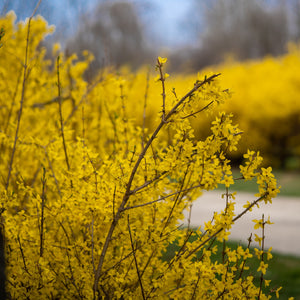
Planting
Forsythias are known for their adaptability and hardiness, but they do have some specific growing requirements to ensure their optimal health and beauty. Here are some general guidelines for planting and caring for forsythia:
Soil: Forsythias prefer well-drained soil that is rich in organic matter. They can tolerate a wide range of soil pH, but prefer slightly acidic to neutral soil with a pH between 6.0 and 7.0. If your soil is too alkaline, you can amend it with sulfur or other acidic materials to lower the pH.
Sunlight: Forsythias thrive in full sun to partial shade. They require ample sunlight to bloom profusely. When choosing a location for your forsythia, make sure it receives enough sunlight throughout the day.
Watering: Forsythias require regular watering, especially during their first few years of growth. Water deeply and thoroughly once or twice a week, depending on the weather and soil moisture levels. Be careful not to overwater, as forsythias can be susceptible to root rot in soggy soil.
Mulching: Mulch around the base of your forsythia shrub to help retain moisture and regulate soil temperature. Use a layer of organic material such as wood chips, bark, or compost, and keep the mulch a few inches away from the stems to prevent moisture buildup.
Pruning: Forsythias bloom on old wood, so it's best to prune them immediately after flowering. Remove dead or damaged branches and shape the plant to maintain its desired size and form. Avoid heavy pruning, as this can reduce blooming in the following season.
By following these basic guidelines, you can ensure that your forsythia shrub thrives and adds beauty to your landscape for years to come.
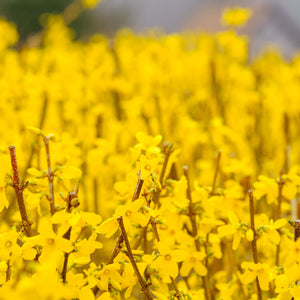
Care
Forsythias, with their radiant blossoms heralding the arrival of spring, thrive when provided with thoughtful care. Follow these comprehensive guidelines to ensure your forsythias dazzle your garden with their vibrant display year after year:
Watering: During the growing season, provide consistent and moderate watering for your forsythias. Aim for approximately one inch of water per week, adjusting based on natural rainfall. Deep and thorough watering is essential to encourage robust root development, while shallow watering should be avoided to prevent stress and dehydration. In times of drought or high temperatures, consider additional watering to maintain optimal soil moisture.
Pruning: Forsythias typically require minimal pruning, but strategic care enhances their overall health and visual appeal. Remove any dead or damaged branches to preserve the shrub's vitality and appearance. Shaping can be employed to achieve the desired size and form. The best time for pruning is late winter or early spring, before the onset of new growth. Utilize clean, sharp pruning tools to minimize the risk of harm to the shrub. Deadheading spent flowers can stimulate new growth and potentially lead to a second blooming, extending the flowering season.
Fertilizing: Fertilization is crucial to promote vigorous growth and abundant flowering in forsythias. Apply a balanced, slow-release fertilizer in spring or early summer, following the recommended application rates and timing provided by the manufacturer. Exercise caution to avoid over-fertilization, as it can negatively impact the shrub's root system. When in doubt, adopt a conservative approach and use less fertilizer, prioritizing the health and longevity of your forsythias.
Soil and Sunlight: Forsythias thrive in well-drained, moist soil and bask in full sunlight. While they demonstrate tolerance to various soil types, ensuring optimal drainage is essential for their well-being. Mulching around the base of the shrub contributes to moisture retention and regulates soil temperature, creating an ideal environment for healthy growth.
Pests and Diseases: Although generally hardy, forsythias may encounter challenges from pests such as aphids, scale insects, or leaf spot diseases. Stay vigilant and monitor your shrubs for signs of damage or disease. Prompt action using suitable insecticides or fungicides, when necessary, will help safeguard the health and vitality of your forsythias.
By adhering to these holistic care guidelines, your forsythias will flourish, becoming a perennial source of beauty, heralding the arrival of spring in your garden for many years to come.
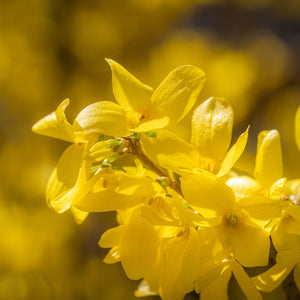
How To Use
Create a captivating focal point in your garden by featuring forsythias as a stunning centerpiece. Plant a cluster of these radiant shrubs in an open area to showcase their brilliant blossoms and graceful form. For an ever-evolving display, consider mixing and matching different forsythia varieties, ensuring your garden is a visual feast throughout the seasons.
Bordering Brilliance: Define the edges of your garden beds with the elegance of forsythias. Their compact and bushy growth makes them ideal for crafting borders that add a touch of sophistication to your outdoor space. Let them weave a tapestry of color and texture along pathways or around other garden features, creating a refined border that frames your landscape beautifully.
Vivid Hedges: Transform utilitarian features into eye-catching elements by using forsythias as hedges. Their dense growth habit not only provides privacy but also introduces a burst of color. Regular shaping maintains a neat appearance, allowing these vibrant hedges to serve as living boundaries that redefine the aesthetics of your garden.
Container Elegance: Embark on a journey of creative container gardening by cultivating forsythias in pots or containers. This flexibility allows you to move these delightful shrubs to different areas, infusing bursts of color onto patios, decks, or balconies. Experiment with various container sizes and shapes to tailor your outdoor space to your unique style.
Companion Planting Harmony: Harness the beauty and functionality of forsythias by incorporating them into companion planting schemes. Their vibrant foliage and flowers complement a variety of other plants. Integrate forsythias into mixed borders or group them with perennials to create visually pleasing and ecologically supportive plant communities.
Whether you're aiming for a striking focal point, an elegant border, a vibrant hedge, or a potted masterpiece, forsythias bring unparalleled elegance and versatility to your landscape. Consider their moderate size, radiant blooms, and adaptability when planning your garden. With forsythias, you're not just landscaping; you're crafting a masterpiece that evolves with the seasons, infusing a touch of sophistication into your outdoor haven.
Conclusion
In the vast expanse of landscaping possibilities, forsythia emerges as a remarkably versatile and enchanting shrub, offering a harmonious blend of colors, forms, and practical uses for your outdoor sanctuary. With their graceful demeanor and adaptability, forsythias contribute a touch of refined beauty to diverse garden settings. As you craft the narrative of your garden, these shrubs become integral characters, weaving a story with their ever-changing hues and intricate foliage. From the delicate blooms of spring to the vibrant foliage of summer and the warm tones of fall, forsythias paint a living canvas that evolves with the seasons, ensuring your landscape remains a perpetual work of art.
Beyond their visual allure, forsythias serve multiple roles in your outdoor haven. Whether cast as a standalone focal point, an elegant border, a vibrant hedge, or a potted masterpiece, these shrubs seamlessly merge aesthetics with practicality. Crafting privacy, defining spaces, and enhancing the charm of your garden, forsythias prove that beauty can indeed serve a purpose.
A testament to their versatility, forsythias make excellent companions to a variety of plants. Their ability to thrive in mixed borders or complement other perennials showcases their compatibility in diverse plant communities. With forsythias as part of your garden ensemble, you're not merely cultivating plants; you're nurturing a harmonious ecosystem.
Embrace the ever-changing melody of your garden with forsythias as key players. Their resilience and adaptability ensure that your landscape remains dynamic, responding to the rhythm of the seasons. By incorporating forsythias, you're creating an outdoor space that resonates with life, color, and the subtle charm of nature.
In the realm of garden design, forsythias transcend being mere shrubs; they are living notes in the melody of your landscape. With thoughtful planting, care, and creative deployment, these versatile shrubs become the crescendo that elevates your outdoor space to a masterpiece. Nurture your garden with the dedication it deserves, and let forsythias be the timeless refrain that brings you joy for years to come.

